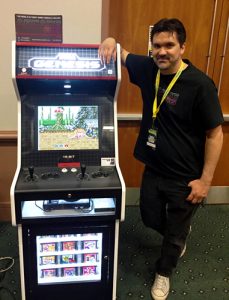 Arcades are becoming popular again, with locations like Galloping Ghosts in Chicago becoming meccas for people looking to experience a bit of the golden age of video games in its most natural environment. For decades, there was a clear difference between the arcade and home console experiences. Many of the games found in one never crossed over to the other, and that was simply the way things were. Gamers took what they could get and lamented the inability to play some of their favorite arcade titles at home and vice versa.
Arcades are becoming popular again, with locations like Galloping Ghosts in Chicago becoming meccas for people looking to experience a bit of the golden age of video games in its most natural environment. For decades, there was a clear difference between the arcade and home console experiences. Many of the games found in one never crossed over to the other, and that was simply the way things were. Gamers took what they could get and lamented the inability to play some of their favorite arcade titles at home and vice versa.
One company is looking to at least remove half the problem in a great way. Ray Price’s Arcade816 is looking to take some of the most iconic game consoles of all time and put them in sexy arcade cabinets so that they can play their favorite games in an arcade setting. The result is a very sleek and practical way to give old consoles new life on modern screens and in locations where more people will experience them.
We spoke to Mr. Price at the 2018 Midwest Gaming Classic and had a chance to chat with him shortly afterward about Arcade816.
Sega-16: Give us a little background about yourself and your history with video games.
Ray Price: My 40-year history with gaming began in 1977 at the age of four, when my old man brought home the Fairchild Channel F game system, the first cartridge-based home console. From there I transitioned to Atari 2600, and then to NES. Super Mario Bros. on NES is what really took my gaming level from casual to fandom.
After high school I landed a job as associate editor for Electronic Gaming Monthly magazine. I was there from mid-1991 to mid-1992. I had the good fortune of being there for the 16-bit console war, what I consider to be the golden age of gaming. It was here that I picked up the graphic design skills that I’m using to build the artwork for my arcade!
In 1997 I created Radd Radio, an Internet radio station which broadcast video game music 24/7. By 2001, Radd Radio had evolved into Gaming FM, which reached thousands of listeners with four different stations featuring different genres of video game music.
In 2014, I started Radd Repro, a shop dedicated to building reproduction game cartridges of ROM hacks and homebrew games for NES, SNES and mostly Genesis.
In 2016 I started Gaming AM, the talk side of Gaming FM, a podcast dedicated to gaming and nerd culture, which has evolved into Radd’s Basement: Nerd Culture Podcast.
Today I’m in the process of building and opening a strange and wonderful new type of video game arcade called Arcade816. Obviously, video games have had a major impact on my life and have inspired me to create and inspire others.
Sega-16: When and how did you decide to put consoles in arcade cabinets?
 Ray Price: In July of 2016, two dear friends of mine opened an arcade called Pixel Blast in the Chicago suburbs. This was something I’d always wanted to do in the back of my mind, but never went through with it. I thought if they could do it, why not me too? But after a time, I began to watch as my friends’ day-to-day problems set in, running an arcade with 30 year old cabinets. A CRT monitor goes out here, a board goes bad there, old joysticks and buttons wear out… and while some parts can be easily replaced, others are not so easy to source and have finite supply left in the world. I thought, “Man, I dunno if I wanna deal with all that!” and became somewhat disenchanted with the whole idea.
Ray Price: In July of 2016, two dear friends of mine opened an arcade called Pixel Blast in the Chicago suburbs. This was something I’d always wanted to do in the back of my mind, but never went through with it. I thought if they could do it, why not me too? But after a time, I began to watch as my friends’ day-to-day problems set in, running an arcade with 30 year old cabinets. A CRT monitor goes out here, a board goes bad there, old joysticks and buttons wear out… and while some parts can be easily replaced, others are not so easy to source and have finite supply left in the world. I thought, “Man, I dunno if I wanna deal with all that!” and became somewhat disenchanted with the whole idea.
One day, out of the blue my wheels began to turn, and I thought, “How can I do what my friends did, but in a really lazy way?” So, I began to dream of an arcade with tiny wall-mounted cabinets that use all new parts, and instead of trying to source arcade boards, I’ll use video game consoles! As much as I love arcades, my heart was always in the home console. I love ‘em all, and I thought, well nobody’s ever tried this before so let’s see what happens! With the rising popularity of tiny consoles that play old games, and the technology to upscale 240p consoles to look good on LCD monitors coming down in price, I felt the time is right, and the world is ready for this. In the end, putting this together has been anything but lazy, but a lot of fun!
Sega-16: What made you decide to build the prototype with a Genesis console?
Ray Price: The beauty of the Genesis is that Sega was very smart in its construction back in the day. It uses all off-the-shelf parts that to this day can be sourced easily. If repairs or modifications are necessary to make this arcade happen, the Genesis is great for tinkering. Additionally, its three-button controller is of a very simple design that made adapting it to an arcade control panel easy and will in turn make the future addition of autofire to the cabinets easy.
Plus, Genesis outputs RGB natively without any mods. I decided early on that it was of grand importance that the games to look as good as is possible with current technology, and I think I’ve nailed that. Using the Genesis was a no-brainer for taking on a project like this. Plus, the Genesis has great games, I mean, come on man, Ghouls n’ Ghosts, Thunder Force, Streets of Rage, Sonic, even Herzog Zweii can be at my arcade!
Sega-16: The design is elegant, combining the classic look of an arcade machine with that of a cool console demo kiosk. How did you decide on the final design?
Ray Price: High praise, man. Thank you so much! That’s what I was going for! So, in my mind, I’m creating arcade cabinets that I feel like the Japanese designers at Sega might have created if such a thing existed. I spent a lot of time scouring Google Images and taking in box art for various consoles, add-ons, and games Sega released. My former experience building repros was a major advantage here. I tried to get a sense of their marketing mindset for these items and transferred it to the cabinet artwork. Big bold logos, the black grid, very Japanese, “less is more” sort of thing. But I didn’t want to leave out the later marketing which included the red stripes. So, once I threw that on, it inadvertently clashed with the black and became amazing.
For the control panel, I wanted to capture the look of the original controller, so even though you’re not playing with the original controller you can feel like you are. I have the benefit of being surrounded by wonderfully talented folks, one of which handled the control panel artwork, while another rendered the cabinet in 3D, so we were able to see the cabinet completed before cutting a single sheet of wood. Early art pieces that looked great individually didn’t work as a set, so I was able to revise without spending money on pricey printouts.
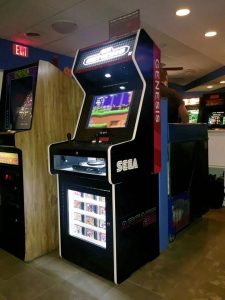
Sega-16: How long does it usually take to build one of these cabinets and how many people are involved?
Ray Price: The prototype took just under a year from planning to unveiling for Midwest Gaming Classic. I was still putting final touches on the cabinet the night before the show! That cabinet was built by just two of us. Future cabinets can be built much more quickly, a matter of days, and will be built in stages. I have a wonderfully talented friend, Jeremy Fox at Prince Arcades, who will be handling the construction of the cabinets from here on. While he’s building the cabinets, I’ll be modding systems and creating artwork. Once I have all the cabinets, I’ll stock them with systems, hardware, and lighting, and then Doc Mack at Galloping Ghost Reproductions is handling my printing needs. They printed the artwork for the prototype cabinet and obviously did a stellar job!
Sega-16: What kind of parts do you use in the construction? Are they the same sticks, buttons, etc. that we’d see in a commercial arcade coin-op?
Ray Price: Yes! Although I’m designing modern cabinets, I want them to feel classic. For this reason, I’ve decided to go with Happ style concave buttons and Competition joysticks. I’m aware some folks prefer Japanese style Sanwa or Seimitsu controls, especially for fighting games; however, I’m going for the classic American-style ‘90s arcade feel, since those are the arcades I feel like people would remember most.
In addition, the cabinets themselves are constructed from MDF, the same material used in most classic arcade cabinets. Although the cabinets are small, the actual playable dimensions and viewing area are identical to a full size cabinet. My cabinets are essentially full side cabinets with the top third sliced out. I based the initial design off a Konami cabinet which I’ve dubbed the Console Cabinet “K.” I recently unveiled the design I’ll use for Nintendo systems. Based off the classic Nintendo arcade cabinet, I’m calling this one Console Cabinet “N.”
Sega-16: You’re not using traditional CRT monitors for your cabinets, correct? How hard has it been to maintain that classic look on new screens?
Ray Price: That’s right! I’m using 1080p widescreen IPS gaming monitors. They have very low latency and a nearly 180° viewing angle. Shortly after I came up with the concept, I began to realize that there is a mountain of logistical hurdles to overcome, one of which is the fact that the built in upscalers in modern LCD monitors are not up to the task of making 240p images look good stretched to 1080p. Right around the same time, my research uncovered a device called the Open Source Scan Converter, or OSSC. This little box takes that pure RGB signal out of the Genesis and incrementally doubles, triples (up to 5x) the size of each pixel. Instead of a stretched and blurry image, you get a crisp, pristine pixel perfect image. It even simulates the scanlines naturally visible on CRT upcales. It accomplishes all this while introducing minimal lag. The other benefit is, the image can be displayed in its native 4:3 aspect ratio, and we just put art over the unused sides of the LCD monitor. I felt like this was the way to go, and since the OSSC is new it’s readily available, and it’s about half the cost of a Framemeister that would need to be sourced from Japan or aftermarket. The result is the games look gorgeous; modern yet familiar, and there’s no perceptible lag.
Sega-16: You’ve tested your Genesis console cabinet prototype at several high-profile locations, like the Midwest Gaming Classic and Galloping Ghosts Arcade. What kind of reception have you received so far?
Ray Price: Taking on a project nobody has ever tried can be scary to say the least. However, the reception has been universally positive which I am very gratified to hear. MGC was a life-changing experience for me personally and my fears are washing away.
Pixel Blast Arcade in Lisle, IL is the current home of the Genesis prototype. At the moment, I’m working on the Nintendo cabinet prototype. When completed, I plan to move the Genesis cabinet to Galloping Ghost Arcade in Brookfield, IL, and put our Nintendo proto in Pixel Blast. In this way the operators can give me feedback on their public reception, but it also helps me learn what needs to be fixed or improved in future cabinets, so that when I open, I will have battle-tested designs ready for everyone’s enjoyment.
So far, I’ve received only reports of praise and positivity. All I can say is thank you to everyone, and I’m so glad you’re enjoying it! I’ll continue to work hard and make this venue amazing!
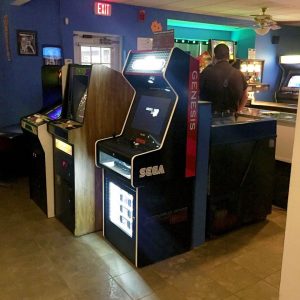 Sega-16: What other consoles do you plan to make cabinets for?
Sega-16: What other consoles do you plan to make cabinets for?
Ray Price: All of ‘em! Atari 2600, NES, SNES, TurboGrafx 16, NEO-GEO, 3DO, PlayStation, Saturn, even portables! I’m keeping it to mostly pixel based, D-pad stuff for now, shying away from polygons and analog sticks (that’s not to say it won’t happen in the future), plus some unexpected designs and surprises! I promise there will be something for everyone and nobody will leave disappointed.
Sega-16: Tell us more about the new venue opening in the Chicago suburbs in 2019.
Ray Price: Arcade816 will feature games and consoles from the 8-bit and 16-bit eras (hence the name) wrapped in modern style arcade cabinets. Admission will be $15 per person, which lasts all day. You can leave the arcade and return as many times as you like for the duration of that day.
Community will be a huge part of this venue. There will be a voting system in place by the time we open, that will allow the players to decide which games will be available for play in the arcade. In this way there’s always something fresh, and I’ll always be rotating games. If you like it, vote for it and it’ll always be there for you to play. Once in a while, I’ll allow games that receive the highest number of votes to become permanent, meaning they’ll never, ever leave. As more games become permanent, I’ll add more cabinets so there’s more variety. Initially we’ll have 50 cabinets, and once a week I’ll do a video stream showcasing what’s new and leaving the arcade, based on your votes, similar to Galloping Ghost’s Monday Mystery Game.
There will be tournaments and high scoring available, I’ll even have a single high scoring kiosk with your choice of system and original controllers, displayed on a CRT TV.
There will also be a museum aspect to the arcade, the design of the cabinet lends itself to having all the original systems, controllers, cartridges and boxes on display. Many people these days put video games in shrink-wrap and in closets never to be played. I feel this is unfortunate. Everything in Arcade816 will be up and working, original hardware and original games for all to enjoy, no emulation! Please look forward to it, and I will look forward to meeting you! You can follow my progress on my Facebook page or or at my development blog.
Our thanks to Ray Price for taking the time for this interview.

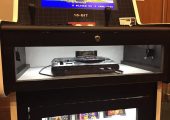
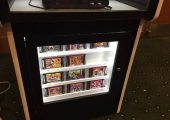
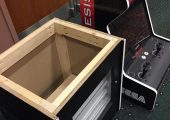
Recent Comments